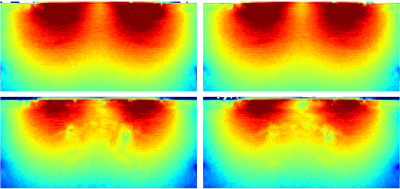0563
Preamp decoupling improves SNR and the earth is flat1Philips Research, Hamburg, Germany
Synopsis
Preamplifier decoupling has been used to isolate elements of receive array coils for decades. For good SNR, decoupling of elements is essential. However, recent research results claim that this just holds for “real” electromagnetic decoupling rather than preamp decoupling as long as the SNR-optimal channel combination is used. We performed experiments on the impact of preamplifier decoupling including also accelerated imaging using SensE. We found no significant difference in SNR between preamplifier decoupled and resonant coil elements.
Introduction
Preamplifier decoupling is a well-known and established technique in array-coil design [1]. In most applications, low-noise-preamplifiers (LNAs) with a very low input impedance are used which are matched via a quarter wave transmission line (often realized by lumped elements and making use of the array-coil inductivities) to the coil element. The characteristic impedance is chosen as the geometric mean of the coil impedance and the optimal noise impedance of the preamplifier. This transforms the low input impedance to a high impedance in the coil element, which reduces the coil current and cross-element signal coupling to a minimum. However, recent studies [2,3,4,5] have shown that the preamplifier input impedance(s), thus also preamp decoupling, has no effect on the final SNR as long as the optimal channel weighting [6,1] is applied.
The need of preamp decoupling was investigated experimentally for standard parallel imaging in [4] using two lumped element quarter wave transmission lines to switch from preamplifier decoupling to resonant matching. In this study, we also used accelerated imaging with SensE. In addition, we preferred using preamplifiers with an optimal noise impedance of (50+0j) Ω to simply switch from preamp decoupling to resonant state by changing a cable length between coil and preamplifier.
Note that the so-called Array Noise Matching [3,5] can be used to further increase SNR above that available with the ordinary element-wise matching. However, in this study we just used the simpler standard element-wise matching neglecting any noise coupling just to simplify the experiment.
Methods
Figure 1 shows the matching of a commercially available WanTCom (WMA3RA-R5) preamplifier. The optimal noise impedance was evaluated for two preamplifiers w.r.t. a closely soldered SMA connector as a reference plane (Agilent N8973A+N4000A) using five different well characterized matching networks. We designed tunable MR compatible (inductor with aluminum screw core) lumped element matching networks which were tuned such that the combination with the preamplifier yields 50 Ω optimum impedance (using a network-analyzer and postprocessing of measured scattering parameters and assuming thermal noise in the matching network). After tuning, we characterized also the matching-preamp combinations as shown in Fig. 2. The resulting optimal impedance differed less than 2 Ω from the desired (50+j0) Ω for both preamplifiers.
We placed a coupled two element array coil [2] (d=10 cm, center distance 11 cm) 1 cm above a loading phantom (0.52 S/m, εr=53) and matched each element to 50 Ω while deactivating the other one. We performed T1-weighted FFE images by connecting coil and preamps via two different transmission line lengths. These cables changed the impedance seen from the loops from a high (real) to a low (real) impedance while leaving the optimum (noise) impedance constant. Fig. 3 shows how the high impedance leads to preamplifier decoupling and thus to separated sensitivity profiles.
We also acquired images using both channels with optimized combination (CLEAR) as well as accelerated imaging via SensE (R=2). From evaluation of 400 single images, we obtained SNR-maps shown in Fig.4.
Results
As can be seen in Fig. 4 there is no significant difference in SNR between the preamp decoupled and the resonant state for both, CLEAR and SensE reconstruction. Just in the center region close to the coil elements, preamplifier decoupling shows a slightly improved SNR.Discussion
For CLEAR reconstruction the existing theory [2,3,5] directly predicts that there is no difference in using preamplifier decoupling vs. resonant matching. In SensE reconstruction, the image has to be unfolded first. However, as the preamp decoupling yields the same matrix multiplication for coil sensitivities and noise covariance, this cancels out again after SensE reconstruction. In practice, the limited resolution of the reference scan might just slightly reduce SNR in regions of high sensitivity gradients.Conclusion
With respect to SNR preamplifier decoupling does not replace electromagnetic decoupling at all when building high performance array coils - not even in accelerated parallel imaging. Consequently, improved preamp decoupling does not improve SNR. Although it eases adjustments, preamplifier decoupling should only be used when it does not come with significantly increased losses (and thus noise) from the matching networks.Acknowledgements
No acknowledgement found.References
[1] Roemer et al.: “The NMR Phased Array”, MRM 1990
[2] Findeklee: “Improving SNR by Generalizing Noise Matching for Array Coils”, ISMRM 2009
[3] Findeklee: “Array Noise Matching---Generalization, Proof and Analogy to Power Matching” IEEE AP 2011
[4] Reykowski et al.: “Do We Need Preamplifier Decoupling?” ISMRM 2011
[5] Findeklee: “Array Noise Matching via the Scattering Matrix” IEEE AP, under review
[6] Appelbaum: “Adaptive Arrays“, IEEE AP 197
Figures



